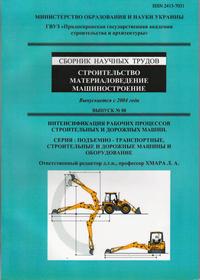Evaluation of effectiveness excavator fitted with telescopic working equipment
Keywords:
Excavator, excavators, telescopic working equipment, evaluation of the effectiveness of the telescopic working equipmentAbstract
Summary. Raising of problem. A promising area of earth-moving equipment is a telescopic working equipment of excavator, which can increase the digging depth and dump height, increase the amount of soil developed on one lot and the radius of the equipment, to quickly change a wide range of geometrical parameters of working equipment, and use a wide range of interchangeable working bodies. In addition, the telescopic working equipment allows workers to combine operations with the simultaneous change in the linear dimensions of the equipment, which leads to a reduction in the cycle time, and perform the work required by the translational movement, for example, the dispersed work for cleaning and planning surfaces earthworks in road construction. The purpose of the article. Develop a system of indicators of evaluation efficiency, of operational properties and a method for determining the operational productivity for single-bucket excavators equipped with the telescopic working equipment. Conclusion. The excavator equipped with a telescopic working equipment, is the best choice for use on special works, such as finishing processing of slopes, cleaning, maintenance, and removal of plants from the banks and bottom of rivers and canals, excavation broad and deep pits. The use of telescopic working equipment allows you to increase the volume of soil developed on one lot. Evaluation of the effectiveness of the proposed system of indicators showed that the best solution under the terms of th e rationalization and optimization of application is within the telescopic working equipment. Besides the use of mechanisms for telescoping the telescopic boom allows to increase productivity compared to traditional operational equipment by 28% ... 40%.
Downloads
Published
Issue
Section
License
Редакція Видання категорично засуджує прояви плагіату в статтях та вживає всіх можливих заходів для його недопущення. Плагіат розглядається як форма порушення авторських прав і наукової етики.
При виявлені у статті більш ніж 25% запозиченого тексту без відповідних посилань та використання лапок, стаття кваліфікується як така, що містить плагіат. У цьому випадку стаття більше не розглядається редакцією, а автор отримує перше попередження.
Автори, в статтях яких повторно виявлено плагіат, не зможуть публікуватися в усіх журналах Видавництва ДВНЗ «Придніпровська державна академія будівництва та архітектури».
Автори, які публікуються у цьому журналі, погоджуються з наступними умовами:
- Автори залишають за собою право на авторство своєї роботи та передають журналу право першої публікації цієї роботи на умовах ліцензії Creative Commons Attribution License, котра дозволяє іншим особам вільно розповсюджувати опубліковану роботу з обов'язковим посиланням на авторів оригінальної роботи та першу публікацію роботи у цьому журналі.
- Автори мають право укладати самостійні додаткові угоди щодо неексклюзивного розповсюдження роботи у тому вигляді, в якому вона була опублікована цим журналом (наприклад, розміщувати роботу в електронному сховищі установи або публікувати у складі монографії), за умови збереження посилання на першу публікацію роботи у цьому журналі.
- Політика журналу дозволяє і заохочує розміщення авторами в мережі Інтернет (наприклад, у сховищах установ або на особистих веб-сайтах) рукопису роботи, як до подання цього рукопису до редакції, так і під час його редакційного опрацювання, оскільки це сприяє виникненню продуктивної наукової дискусії та позитивно позначається на оперативності та динаміці цитування опублікованої роботи (див. The Effect of Open Access).

